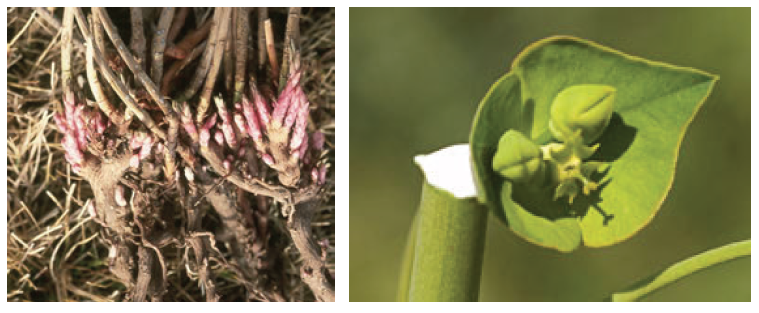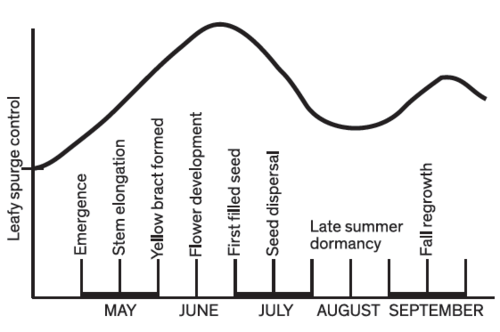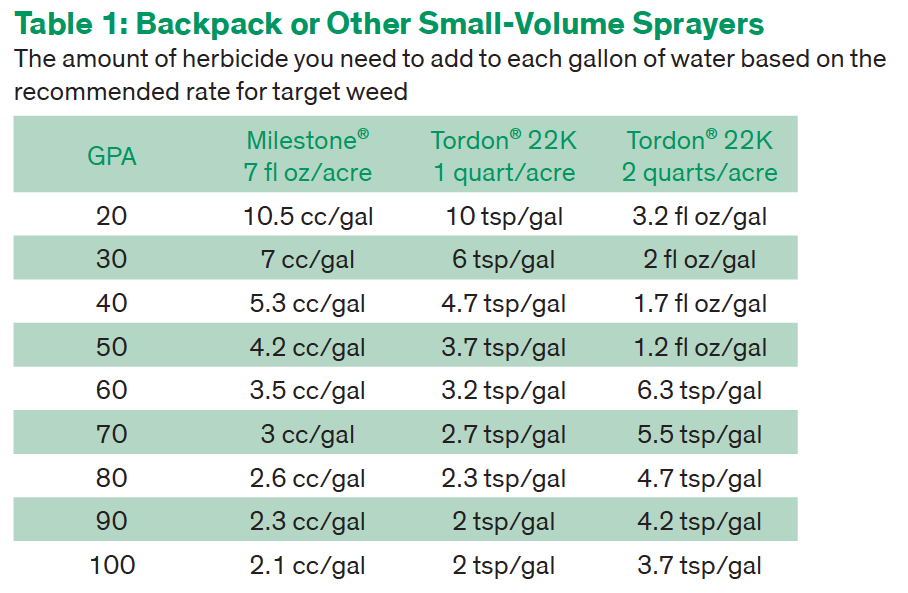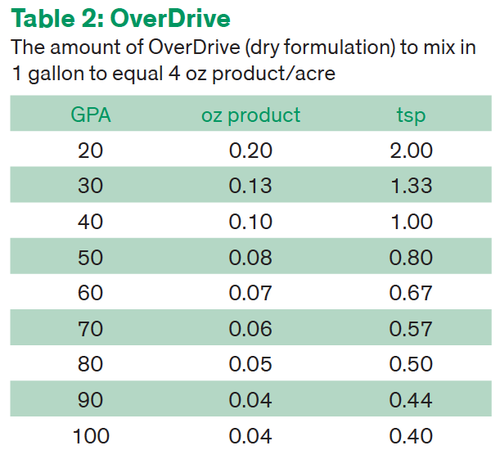
Leafy Spurge (Euphorbia esula) is a deep rooted, non-native perennial plant capable of vigorous vegetative growth. Dense infestations of the weed often create biologically sterile monocultures excluding desirable vegetation. The displacement of desirable vegetation by leafy spurge significantly reduces the economic value of infested rangeland. Leafy spurge is a cold season broadleaf plant beginning growth early in the spring. The root system can penetrate as deep as 29 feet which allows the plant to survive extreme droughts, yet it can also tolerate months of flooding. Much of the leafy spurge root system contains reproductive buds capable of producing new shoots which can emerge from depths of up to three feet. Each flower produces a capsule that contains three seeds. When the stem matures, the capsules explode propelling seeds up to 15 feet. A single flowering stem may produce over 150 seeds. Leafy spurge infests many habitats such as roadsides, other non-crop areas, riparian wetlands, wildlands, rangelands and pastures.

COMMITMENT
Control of leafy spurge requires a long term commitment and follow-up treatment of seedlings and new plants from root buds. Treated sites must be evaluated and checked each year and new plants controlled with the objective of ether containing the perimeter of mature infestations, and utilizing other integrated tools within boundaries or controlling infestations less than 5 years old.
Do not treat too early in the spring. Leafy spurge is the most sensitive to herbicide treatments applied when the true flower is visible (after yellow bract is formed in late spring or early summer) or in early to mid- September after stems have developed new fall re-growth. Herbicide applications made after seed dispersal is not as effective since plants become dormant during the hot, dry summer. Refer to the application timing graph on the left which shows growth stages for optimum control. Herbicide applications in excess of 25 to 50 gallons of spray solution per acre, depending on leafy spurge canopy, will allow the herbicide to penetrate the leafy spurge vegetative canopy and may increase control due to increased herbicide uptake by roots.
RATE RECOMMENDATIONS
Apply Tordon® 22K herbicide (picloram) alone at 1 to 2 quarts/acre. Add 2,4-D at 1 quart/acre (1 lb ae/acre) to rates below 1 quart/acre of Tordon 22K. Research has shown that the addition of OverDrive at 4 oz product/acre may improve leafy spurge control by up to 20%. Reducing the Tordon rate below 1 quart/acre whenmixing with OverDrive is not recommended. Add a non-ionic surfactant or blend at 0.25% v/v (1 pint/100 gallons). Herbicide treatments should be reapplied when control drops below 75% in successive years.
For control of noxious or invasive weeds as listed by federal states, or local authorities, do not apply more than 1.0 lb active ingredient (2 quarts of Tordon 22K/acre) per annual growing season as a broadcast treatment.
SENSITIVE SITES (AROUND TREES, NEAR WATER, OR OTHER AREAS NOT SUITABLE FOR CERTAIN HERBICIDES SUCH AS PICLORAM OR AMINOCYCLOPYRACLOR)
Apply GrazonNext® HL herbicide at 2.1 pints/acre plus OverDrive at 4 oz/acre or a tank mix of 7 fl oz/acre Milestone® plus 1 quart/acre 2,4-D plus 4 oz/acre of OverDrive.
Research results have shown this mixture to provide excellent in season control of leafy spurge with up to 75% stand reduction the following year. Re-treatment will be necessary in successive years for long term control.
For treatment with small sprayers, use the following charts (Table 1 for liquids and Table 2 for OverDrive) to determine how much herbicide to mix in 1 gallon of water for the various application rates listed in rate recommendation section.


Celestine Duncan contributed to this article.
®™ Trademarks of Corteva Agriscience and its affiliated companies.
Milestone and GrazonNext HL herbicides have no grazing or haying restrictions for any class of livestock, including lactating dairy cows, horses (including lactating mares) and meat animals prior to slaughter. However, label precautions do apply to forage treated with Milestone and GrazonNext HL and to manure from animals that have consumed treated forage within the last three days. GrazonNext HL and Milestone are not registered for sale or use in all states. Contact your state pesticide regulatory agency to determine if a product is registered for sale or use in your state.
Tordon 22K is a federally Restricted Use Pesticide. Always read and follow label directions.©2021 Corteva
Published May 2013; updated June 2019
Techline Invasive Plant News
Sharing innovative research, success stories and tips with invasive plant managers.